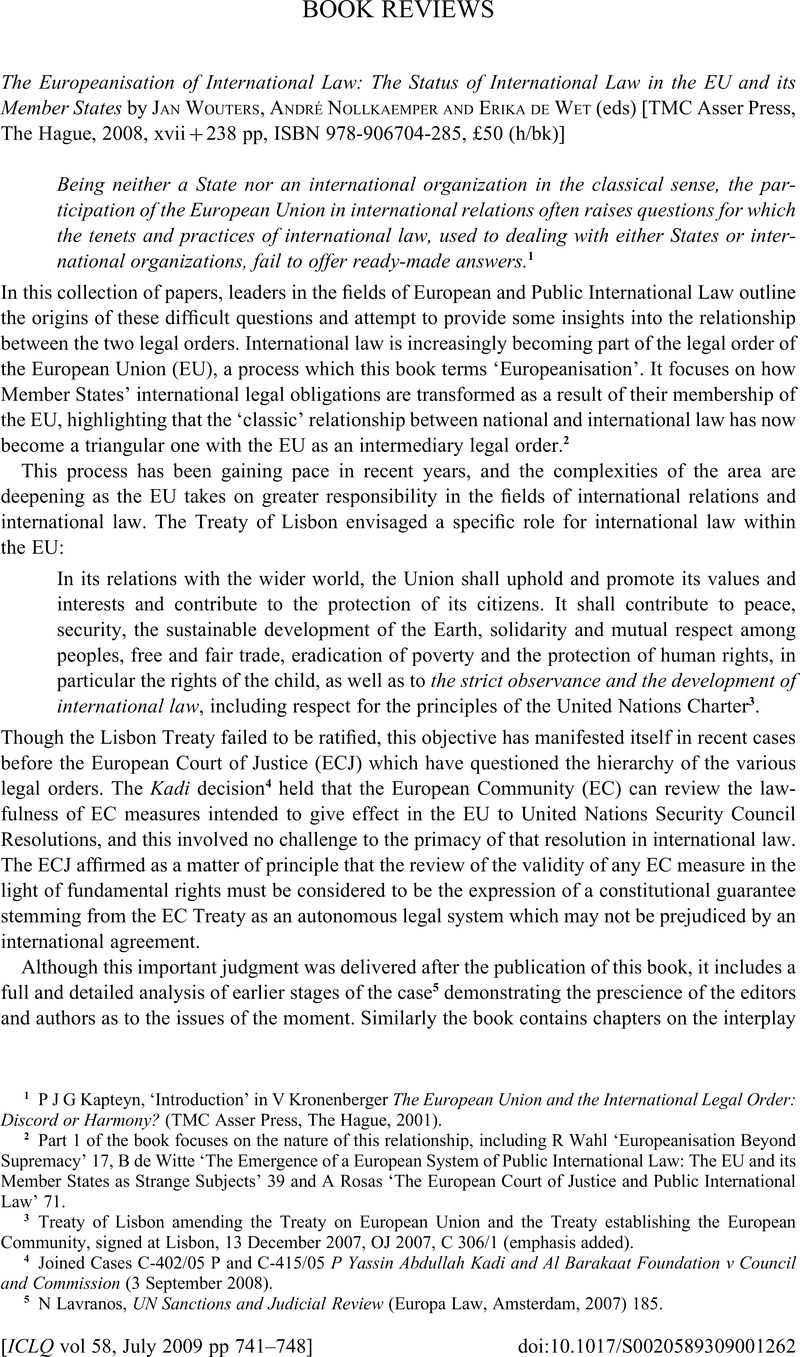Published online by Cambridge University Press: 14 July 2009

1 P J G Kapteyn, ‘Introduction’ in V Kronenberger The European Union and the International Legal Order: Discord or Harmony? (TMC Asser Press, The Hague, 2001).
2 Part 1 of the book focuses on the nature of this relationship, including R Wahl ‘Europeanisation Beyond Supremacy’ 17, B de Witte ‘The Emergence of a European System of Public International Law: The EU and its Member States as Strange Subjects’ 39 and A Rosas ‘The European Court of Justice and Public International Law’ 71.
3 Treaty of Lisbon amending the Treaty on European Union and the Treaty establishing the European Community, signed at Lisbon, 13 December 2007, OJ 2007, C 306/1 (emphasis added).
4 Joined Cases C-402/05 P and C-415/05 P Yassin Abdullah Kadi and Al Barakaat Foundation v Council and Commission (3 September 2008).
5 N Lavranos, UN Sanctions and Judicial Review (Europa Law, Amsterdam, 2007) 185.
6 Despite early divergences in cases brought before both the ECJ and European Court of Human Rights in recent years (see eg Case C-374/87 Orkem v Commission [1989] ECR 3283 and Funke v France [1993] 16 EHRR 297) the ECJ has been careful not to create diverging jurisprudence to facilitate cooperation between the two courts, and the Bosphorus case (Bosphorus Hava Yollari Turzim v Ireland, App No 45036/98 (ECtHR, June 30 2005)) demonstrates the reciprocal willingness of the Strasbourg Court to take note of the ECJ's decisions. This is discussed in detail in J Callewaert, ‘“Unionisation” and “Conventionisation” of Fundamental Rights in Europe: The Interplay between Union and Convention Law and its Impact on the Domestic Legal Systems of the Member States' 109.
7 Joined Cases C-120/06 P and C-121/06 P Fabbrica Italiana Accumulatori Motocarri Montecchio SpA (FIAMM) and Others v Council and Commission, 9 September 2008, which definitively rules out the possibility that Community institutions could be held liable for damages stemming from EC non-compliance with WTO law. C Tietje ‘The Status of International Law in the European Legal Order: The Case of International Treaties and Non-binding International Instruments in Wouters, Nollkaemper and de Wets (eds) The Europeanisation of International Law (TMC Asser Press, the Hague, 2008) 55.
8 P J Kuijper, ‘Customary International Law, Decisions of International Organisations and Other Techniques for Ensuring Respect for International Legal Rules in European Community Law’ in Nollkaemper and de Wets (eds), The Europeanisation of International Law (TMC Asser Press, the Hague, 2008) 87.
9 Though note that international lawyers tend to reject this analysis in favour of defining the EC and EU as international organizations, as discussed by de Witte at 40.
10 R Wahl, ‘Europeanisation Beyond Supremacy’ 23.
11 A Epiney, B Hofstötter, and M Wyssling, ‘The Status of “Europeanised” International Law in Austria, Switzerland and Liechtenstein’ 140.
12 N Chronowski, T Drinóczi, ‘A Triangular Relationship Between Public International Law, EC Law and National Law? The Case of Hungary’ 176.
13 Earlier volumes include M Koskeniemmi, International Law Aspects of the European Union (Kluwer Law International, 1998), which includes only first and second pillar aspects and was written prior to the Treaty of Amsterdam, and V Kronenberger The European Union and the International Legal Order: Discord or Harmony? (TMC Asser Press, The Hague, 2001) which whilst current at the time of publication has in some respects been quickly superseded by the fast-paced developments in this field.